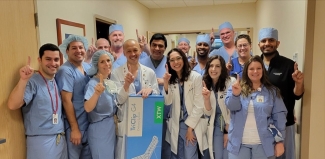Center for Coronary Artery Disease
Patient Information & Resources
FAQs about Coronary Artery Disease

What is Coronary Artery Disease (CAD)?
Coronary artery disease, or CAD, happens when plaque builds up over a period of time along the inner walls of your coronary arteries. This causes your arteries to harden and narrow, which decreases blood flow to your heart. As a result, your heart doesn’t get the blood, oxygen and nutrients it needs, which can lead to a heart attack.
Many patients with coronary artery disease have complex lesions (or blockages) that are challenging to treat with conventional techniques and tools. These types of lesions include chronic total occlusions, which are vessels that are completely blocked for more than three months. Complex lesions can also be highly calcified, difficult to cross with traditional wires or balloons or located at the intersection of two coronary arteries. Many patients have had prior failed attempts to re-open their coronary arteries. By collaborating with other cardiology fields, such as non-invasive imaging, advanced heart failure and cardiac surgery, such patients can be successfully treated, improving their quality, and often quantity, of life.
On the Pulse
|
On the Pulse | Heart Attacks, Blockages & Stents | Emmanouil (Manos) Brilakis, MD |
On the Pulse | Life After Coronary Artery Bypass Graft | Drs. Emmanouil Brilakis & Vinnie Bapat |
Who is at risk for developing CAD?
One-third of Americans have at least one of these modifiable risk factors for CAD:
- Smoking
- High blood pressure
- High cholesterol
- Diabetes
- Obesity
- Poor diet
- Physical inactivity
Nonmodifiable risk factors include increased age, male gender and hereditary predisposition for CAD.
Discuss with your physician about lifestyle changes and/or medications that can help prevent heart disease.
How common is CAD?
CAD is the most common of all heart diseases and the leading cause of death in the world, for both men and for women. CAD affects 15 million American adults.
How is CAD diagnosed?
Diagnosis is based on your symptoms and risk factors. Your doctor will perform a physical examination and determine if further tests are needed. These include non-invasive tests, such as an electrocardiogram, an ultrasound, a CT scan, and a stress test or invasive ones, such as an angiogram.
The first symptom of CAD can be a heart attack. A heart attack can feel different for men and women. If you think you or someone near you is having a heart attack, dial 9-1-1 immediately. You can learn about the different symptoms of CAD at https://www.cardiosmart.org/topics/coronary-artery-disease
How is CAD treated?
Treatment may involve:
- Lifestyle changes like smoking cessation
- Medications such as aspirin (which is an antiplatelet drug) or statin (which lowers your blood lipids) depending on the extent of CAD disease
- Invasive procedures such as balloon angioplasty and stent placement or coronary bypass graft surgery.
What happens after I get a stent?
Depending on how you feel and your physician’s clinical judgement, you may resume your daily activities. However, this is a great opportunity to modify potential risk factors in order to halt further progression of the disease. Compliance with medication is one of the most important goals in this case, along with a heart-healthy diet and a regular exercise program.



